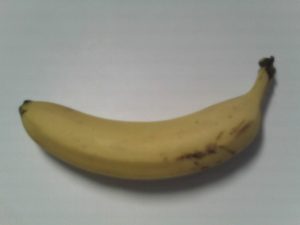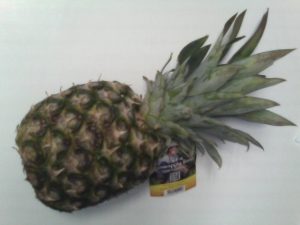
It has been an old dream to teach a computer to see, i.e. to hold something in front of a camera and let the computer tell you what it sees. For decades it has been exactly that: a dream – because we as human beings are able to see, we just don’t know how we do it, let alone be precise enough to put it into algorithmic form.
Enter machine learning!
As we have seen in Understanding the Magic of Neural Networks we can use neural networks for that. We have to show the network thousands of readily tagged pics (= supervised learning) and after many cycles, the network will have internalized all the important features of all the pictures shown to it. The problem is that it often takes a lot a computing power and time to train a neural network from scratch.
The solution: a pre-trained neural network which you can just use out of the box! In the following we will build a system where you can point your webcam in any direction or hold items in front of it and R will tell you what it sees: a banana, some toilet paper, a sliding door, a bottle of water and so on. Sounds impressive, right!
For the following code to work you first have to go through the following steps:
- Install Python through the Anaconda distribution: https://www.anaconda.com
- Install the R interface to Keras (a high-level neural networks API): https://keras.rstudio.com
- Load the
keraspackage and the pre-trainedResNet-50neural network (based on https://keras.rstudio.com/reference/application_resnet50.html): - Build a function which takes a picture as input and makes a prediction on what can be seen in it:
- Start the webcam and set the timer to 2 seconds (depends on the technical specs on how to do that!), start taking pics.
- Let the following code run and put different items in front of the camera… Have fun!
- When done click the Stop button in RStudio and stop taking pics.
- Optional: delete saved pics – you can also do this with the following command:
library(keras) # instantiate the model resnet50 <- application_resnet50(weights = 'imagenet')
predict_resnet50 <- function(img_path) {
# load the image
img <- image_load(img_path, target_size = c(224, 224))
x <- image_to_array(img)
# ensure we have a 4d tensor with single element in the batch dimension,
# the preprocess the input for prediction using resnet50
x <- array_reshape(x, c(1, dim(x)))
x <- imagenet_preprocess_input(x)
# make predictions then decode and print them
preds <- predict(resnet50, x)
imagenet_decode_predictions(preds, top = 3)[[1]]
}
img_path <- "C:/Users/.../Pictures/Camera Roll" # change path appropriately
while (TRUE) {
files <- list.files(path = img_path, full.names = TRUE)
img <- files[which.max(file.mtime(files))] # grab latest pic
cat("\014") # clear console
print(predict_resnet50(img))
Sys.sleep(1)
}
unlink(paste0(img_path, "/*")) # delete all pics in folder
Here are a few examples of my experiments with my own crappy webcam:

class_name class_description score 1 n07753592 banana 9.999869e-01 2 n01945685 slug 5.599981e-06 3 n01924916 flatworm 3.798145e-06

class_name class_description score 1 n07749582 lemon 0.9924537539 2 n07860988 dough 0.0062746629 3 n07747607 orange 0.0003545524

class_name class_description score 1 n07753275 pineapple 0.9992571473 2 n07760859 custard_apple 0.0002387811 3 n04423845 thimble 0.0001032234

class_name class_description score 1 n04548362 wallet 0.51329690 2 n04026417 purse 0.33063501 3 n02840245 binder 0.02906101

class_name class_description score 1 n04355933 sunglass 5.837566e-01 2 n04356056 sunglasses 4.157162e-01 3 n02883205 bow_tie 9.142305e-05
So far, all of the pics were on a white background, what happens in a more chaotic setting?

class_name class_description score 1 n03691459 loudspeaker 0.62559783 2 n03180011 desktop_computer 0.17671309 3 n03782006 monitor 0.04467739

class_name class_description score 1 n03899768 patio 0.65015656 2 n03930313 picket_fence 0.04702349 3 n03495258 harp 0.04476695

class_name class_description score 1 n02870880 bookcase 0.5205195 2 n03661043 library 0.3582534 3 n02871525 bookshop 0.1167464
Quite impressive for such a small amount of work, isn’t it!
Another way to make use of pre-trained models is to take them as a basis for building new nets that can e.g. recognize things the original net was not able to. You don’t have to start from scratch but use e.g. only the lower layers which hold the needed building block while retraining the higher layers (another possibility would be to add additional layers on top of the pre-trained model).
This method is called Transfer Learning and an example would be to reuse a net that is able to differentiate between male and female persons for recognizing their age or their mood. The main advantage obviously is that you get results much faster this way, one disadvantage may be that a net that is trained from scratch might yield better results. As so often in the area of machine learning there is always a trade-off…
Hope this post gave you an even deeper insight into the fascinating area of neural networks which is still one of the hottest areas of machine learning research.
UPDATE October 31, 2022
I created a video for this post (in German):

2 thoughts on “Teach R to see by Borrowing a Brain”